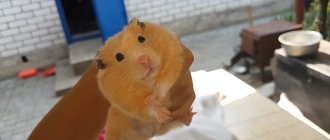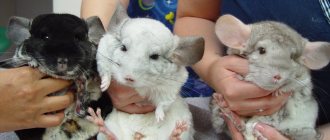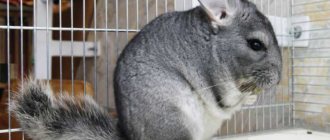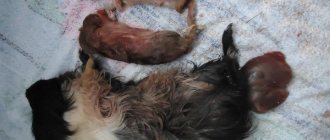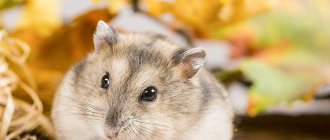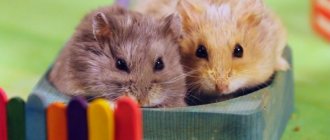What do newborn jungarians look like?
Not everyone gets to see newborn hamsters.
When the female is about to give birth, she hides in the nest. Labor usually begins at night or early in the morning and lasts 1-2 hours. Hamsters give birth on their own. The female takes a comfortable half-sitting position and removes the jungarians from the genital tract with her teeth. She then ruptures the membranes so the newborns can breathe.
Further, the little jungarians are constantly with their mother in the house. You cannot take them out of the cage or touch them with your hands - due to the foreign smell, the hamster can kill the offspring.
Newborn Djungarian hamsters are absolutely helpless. They are born weighing no more than 2 grams. The size of the baby's body does not exceed 2 cm. There is no hair at all on the body of newborns. Their skin is reddish-pink and very thin. It seems that you can see the internal organs underneath.
Newly born Djungarians have a disproportionately large head. Ears and eyes are closed. More precisely, the organs of vision are located under a thin skin through which the dark eyeballs are visible. Externally, hamsters resemble worms with short legs.
Newborns have quite large mouths. When the jungarik opens it, the formed teeth are clearly visible inside.
Already on the second or third day of life of newborns, you can determine what color they will be. Depending on the shade of the coat, the skin of the Djungarians darkens or becomes lighter.
Childbirth
A few days before giving birth, the cage is thoroughly cleaned. In order not to make a mistake with the period, all important dates are recorded (mating, successful conception).
The fact that birth is approaching is often indicated by the behavior of the dwarf. She loses her appetite and becomes thirsty. She spends a lot of time in a nest equipped for babies. Usually the birth of cubs occurs at night. It is not recommended to interfere with the process so as not to irritate the female.
The maximum number of babies per hamster is 18. But usually there are 4-6 babies in a litter. Childbirth lasts 1.5-2 hours, with intervals of 10-15 minutes between the appearance of each baby.
Females often destroy weak or dead offspring to make room for healthy young. This is a natural process, but you should not allow your hamster to eat the entire litter.
How to breed hamsters
The body length is 13-13.5 centimeters, with 1.5 centimeters being on the tail. Hamsters have a body covered with fluffy, thick, soft fur of a golden color, which attracts attention. In nature, it lives in Syria and in the vicinity of the city of Aleppo and, according to some sources, in eastern Turkey
Recently, this species has become a popular pet around the world, due to its miniature size, unpretentiousness, hardiness and very prolific.
But I want to note that it is not as easy to breed Syrian hamsters at home as it seems at first glance. Since a child can take care of a hamster under adult supervision, breeding should only be done by an adult who is responsible for his actions. And so, if you still decide to start breeding Syrian hamsters at home, then it is better to choose a pair of the same, certain age - preferably no younger than 3 months, but no later than 6 months, healthy and with a healthy nervous system, since all these factors will influence subsequent offspring The color of the cubs will not directly depend on the color of the parents, since the genotype plays the main role. Syrian hamsters breed at home all year round. You need to place a male with a female during her heat; if the female is supportive, then you can leave them together for 20-30 minutes, but not leave them unattended, since females can be aggressive and can maim or kill the male. The female’s pregnancy lasts 2 = 2.5 weeks, so on the 14th day the female needs to be placed in a separate place for keeping, be sure to fill the container with sawdust at least 5 centimeters - this is necessary for the female to create a nest since reproduction occurs at home and for surface cleansing, since before and after childbirth the first time, it is better not to disturb the female Syrian hamster. Childbirth lasts 4-7 hours, the cubs are born blind and without fur, but already on the 5th day they have light fluff, and on the 16th day their eyes open and hearing appears. The cubs can be weaned on the 28th day of life, since the female Syrian hamster stops feeding them by this time. By the first month of life, Syrian hamster cubs reach a weight of 60-70 grams; during this period, it is necessary to separate the hamsters by gender in order to avoid unwanted mating, as this can lead to negative consequences in the future.
Breeding another breed of hamster, the Djungarian, is also popular at home. The peculiarity is that puberty occurs in 3-6 weeks, although it is better to avoid this time, since the hamster’s body develops quickly, they are more demanding in their maintenance than Syrian hamsters and require more vain self-care. The technology for breeding Djungarian hamsters at home is similar to breeding other breeds of hamsters. Healthy, full-fledged hamsters are chosen for mating; it occurs during the female’s estrus. For breeding Djungarian hamsters, a separate container is used, into which the female is placed after mating. The container should be filled with sawdust and a drinking bowl with boiled water; there is no need to put anything else in, since the cubs are born very small and can fall out of the nest or injure themselves with foreign objects. When breeding hamsters, the main thing is to follow simple rules. In the last week of pregnancy, do not disturb the female; this should not be done for 12 days and after the birth of the babies, since during this period the female is very anxious and can simply destroy her offspring - cannibalism is very relevant for hamsters. Be sure to keep an eye on the feeder so that the food is always present and fresh, since if the female does not have enough milk, in this case she will also destroy, although only part of the offspring. When the critical 2-week period has passed, you can carefully clean the container without touching the nest. At this age, cubs can be fed with soft food and grated vegetables.
After 3 weeks, the cubs can be separated from the female, transplanting them to a separate place, and when the hamsters are a month old, do not forget to seat them by gender, that is, girls and boys separately, this is very important in breeding hamsters, otherwise unpleasant consequences may arise in the form of unhealthy offspring in the future. After this, the hamsters can be picked up and played with, that is, “turned into pets,” which is not unimportant for their development.
How to care for newborns
You should know that caring for pets after birth should be kept to a minimum. After all, if the baby acquires an unfamiliar smell after being picked up, the mother may refuse it. Because you make her feel anxious by constantly looking into the cage, she may also eat the offspring. Do not pick up the babies, do not try to look at them, and try not to approach the cage again.
Djungarian hamsters need to be cared for in the same way as Syrian ones.
How to feed
After the birth of the babies, the female will need balanced nutrition in sufficient quantities. A lack of protein is especially dangerous, since the female can replenish its reserves in her body at the expense of born hamsters. The same will happen if she considers that the amount of food received will not allow her to feed her offspring.
We recommend that you familiarize yourself with the characteristics of an albino hamster.
These days you should limit succulent food, because a thrifty rodent can drag some of it into the nest, where it will begin to rot and can cause dangerous diseases. It is best to buy special food at a pet store - there are enough vitamins and minerals there. Don't forget to provide the female with clean, fresh water.
In the first week, it is enough for babies to receive only mother's milk. In order for the microflora necessary to digest food to form in the intestines, they eat their own feces. After a week, dwarf birds can try the food that the mother brings to the nest. Next, you will need to increase the amount of food you give to the female so that the babies also eat it. Food is given in the morning and evening, try not to stick your fingers into the cage.
Feeders and drinking bowls are placed so that dwarfs can reach them, but not fall into them. There should be no open bowls of water at the bottom of the cage.
It happens that a female may give birth and refuse to feed her offspring, or they will be left without milk due to her death. In this case, it is almost impossible to get them out on your own; you can try if they are already more than 10 days old. It is recommended to place the babies with another female who already has offspring. To do this, while she is sleeping, someone else's hamsters are carefully picked up, wearing gloves, or with a spoon, rubbed with a piece of bedding taken from the new mother and placed in a common pile with their own children.
Important! None of the substitutes contain the necessary disease-fighting antibodies found in breast milk.
If there is no such female, you can try giving them baby food or Royal Canin cat milk replacer. Infant formula is prepared as indicated in the instructions and given warm. The baby is placed in a column and milk is squeezed out drop by drop, slowly, from a pipette or insulin syringe (after removing the needle). If you squeeze out too much, the mixture may enter the lungs and your pet will suffocate. This needs to be done every 1.5 hours. After finishing feeding, lightly massage the baby's belly and place it in a warm nest. Monitor the condition of the discharge.
Such hamsters need to be switched to adult food as soon as possible, so from the 7th day a little ground grain is added to the food mixture. You can put a feeder with vegetable puree, but do not leave it unattended.
From the 10th day you can place feeders with boiled eggs, sprouted wheat, oats, grated carrots or zucchini. From the 14th day, the number of meals is reduced to 6 per day, and the mixture, together with solid food, is ground to the state of sour cream. From the 21st day you no longer need to use a syringe or pipette; hamsters can eat from a bowl. From the 28th day, formula milk is removed from the diet and replaced with oatmeal or buckwheat baby porridge without milk, sugar, additives or flavorings. Rice can cause constipation in hamsters, and other types can cause allergies. This continues for up to 40 days.
You will be interested to know what a royal hamster looks like.
Month-old babies should eat solid and juicy food every day (zucchini, carrots, greens, sprouted seeds), with an interval of 2 days - protein (low-fat cottage cheese, boiled egg or meat, mealworm larvae, dry granules for puppies).
Arrangement of the cage
The cage should be placed where there will be less people and pets walking near it, so as not to provoke anxiety in the mother. You can't have popping noises or loud noises at home. Tell your children not to play with or handle the hamster for the next 3 weeks. Maintain the room temperature within +21...+25°C, shade bright sunlight, and avoid drafts.
The bedding is changed no later than a few days before the female begins to give birth. The next cleaning should take place no earlier than the babies are 2 weeks old. Let the female have at her disposal a piece of paper towel from which she can make a nest, and a house in order to hide the offspring from prying eyes. The offspring of the jungarik are very mobile, despite their helplessness, and can easily end up far from the nest or even fall out of the cage. In this case, you can only take it to return it with a spoon or with gloves. You can lie the baby down for a while in the corner of the cage where the toilet is located.
Important! Small hamsters can suffocate in a nest made of rags or cotton wool.
To prevent the baby from breaking when falling, make sure that the cage has a small distance between the bars and is single-tiered. Ladders and other objects that allow the hamster to reach heights should be removed. A wheel can also cause injury if it stands on a stand and consists of crossbars. If you did not know about pregnancy and have already discovered the result in the cage, carefully close the cage, trying not to leave your smell anywhere. The male should be placed in a separate cage. Sometimes the female throws the dead baby out of the nest. You can guess this by the lack of motor activity in the baby, as well as cold, bluish skin. While the mother is not looking, you can take a piece of toilet paper and remove it from the cage.
What do newborn hamsters look like?
The owners of babies are not always able to satisfy their curiosity about what newborn hamsters look like. You cannot put your hands into the cage, much less pull the kids out. You will be able to see them when they begin to crawl out of there themselves. This will happen no earlier than in a week.
They are born with absolutely no pubescence. The animals' skin is soft and pink. It is thin and transparent, giving the impression that the animals are “glowing”. They even have visible internal organs. By the end of the first day they will darken or lighten, depending on the future color of the fur. Newborns may squeak if they are not happy with something (cold or hungry). With a good mother they are silent.
The babies do not at all resemble adult hamsters; rather, they resemble small pink “worms with legs” the length of a finger phalanx. A baby hamster at birth weighs from 1 to 2.5 grams. To say that their eyes are closed will be both true and false, because they are not visible at all (only dark dots under the skin). The ears don't stick out yet either. But you can immediately see that this is a real rodent. When the animals open their mouth (it seems huge compared to their body), their teeth are visible.
Newly born Djungarian hamsters and, for example, Syrians are absolutely identical in appearance. They may vary in size, since more Syrians are born, they will be correspondingly smaller. External differences will appear a little later.
How big do Syrian hamsters grow?
One of the popular rodent companions today is the Syrian or Central Asian hamster. This is a medium-sized animal with a stocky, thick body. Its muzzle is short, with large cheek pouches. The ears are small, covered with fur. The tail is almost invisible due to the fur. Its length is about 1.5 cm. The paws are strong and wide. There are 4 toes on the front ones, 5 on the back ones. The wool can be colored in various shades. The most common of them is golden.
If the hamster is well cared for and fed a balanced diet, it can reach a maximum length of 13–14 cm. Individual adults can grow up to 18 cm. At birth, babies have a body length of 2–3 cm.
Did you know? In their cheek pouches, hamsters are able to carry food that weighs twice as much as their body weight.
Complications during childbirth
Toxicosis
A disease that occurs in the last days of pregnancy. Leads to the death of the female and brood during childbirth or in the first days after. There is no cure.
Pathology of childbirth
In females older than 10 months, the joints of the pelvic bones lose their elasticity, which is why the animal cannot give birth. Large fruiting is possible if there are few cubs (1-3 pieces). In such situations, strong contractions of the uterus cannot push the fetus out. If the female pushes for more than 10-15 minutes, and the baby does not appear, a caesarean section is necessary.
How long it takes hamsters to give birth depends on the number of children. The mother can rest for a long time between the birth of her babies, and even eat. There should be no unproductive fights.
Death of fetuses in the uterus
With infections, poor nutrition or genetic deformities, the cubs may die. The female is unable to give birth and dies from sepsis. Treatment is surgery to remove the uterus.
Why do little hamsters die?
There are several possible causes of death:
- The mother refused to feed the cubs. If the female moves to the opposite end of the cage, you can place her with the offspring on the first day. If the instinct does not manifest itself within 24 hours, it is better to find another provider or give milk to the newborns yourself.
- Congenital injuries.
- Diseases. Most often, cubs die due to milk fever. The pathogen is transmitted through mother's milk. Hamsters become lethargic and have bloating. With timely treatment, young animals can be saved.
- Incorrectly selected diet for the female. A lack of protein will result in decreased milk production. The female can independently destroy the cubs.
Timely measures can often save newborns. However, in some situations, humans are unable to help hamsters.
Home improvement
For normal activities, the animal is provided with a spacious and comfortable home. It is allowed to use a plastic house, a traditional cage or a large aquarium.
The house should have enough space for:
- Small storage room.
- Toilet.
- Feeders and drinkers.
- Areas for activity.
- Bedrooms.
The pet will choose how to distribute its housing into zones. Therefore, it is better to give him free rein rather than try to accustom him to the designated places.
The house should be placed in a secluded place, protected from direct sunlight and street noise.
Cage selection criteria
There are several parameters that are taken into account when choosing a suitable home for a pet:
- Dimensions. They are determined taking into account the size of the pet. Small individuals lead an active lifestyle and need a supply of free space for play. The optimal dimensions of a hamster cage are 60 cm in length and 40 cm in width. The height of the structure does not play a special role.
- Material of manufacture. It is not advisable to use wooden cages for keeping rodents, since the animals will constantly gnaw on them and run away. The best solution would be a plastic or metal enclosure.
- Bottom type. It is recommended to choose designs in which the bottom is made in the form of a solid tray with a pull-out system. This will make it easier to clean the surface from dirt.
- Roof. Like the bottom, it is available in a removable format. This option will allow you to quickly remove the animal from the enclosure.
Sawdust
The optimal filler material for the cage is sawdust in granular form. You can also use corn raw material, hay and even plain paper, provided that it does not contain flavorings.
One of the unsuitable fillers is cotton wool. It is dangerous for miniature breeds, which can become entangled in the fibers.
Sawdust for filling the cage.
Drinker and feeder
As a drinking bowl for a hamster, you can use a simple bowl into which water is poured. The advantage of this option is its availability.
However, a rodent can easily turn the container over, being left without nutritious moisture on a hot summer day. In addition, particles of food or filler get inside the bowl, which negatively affects the quality of the liquid.
A feeder for the grain mixture is an optional attribute for the animal itself. It is more needed for the convenience of caring for the cage and maintaining cleanliness. However, the container in which vegetables, herbs, fruits and liquid food will be stored is irreplaceable.
When choosing a feeder, you should take into account that your pet can turn it over. Therefore, it is better to purchase a product with a heavy bottom made of ceramic or metal. In addition, you can install a hanging version in the cage, similar to bird models.
Drinking bowl for a hamster.
Toys and attractions
Hamsters are active pets that lead an active lifestyle. Therefore, in the enclosure it is necessary to provide a running wheel, a ladder and a slide where the rodent will spend its daily reserve of energy. Some owners buy a walking ball that will allow the animal to walk around the apartment.
If desired, you can design a park by installing labyrinths and obstacles from scrap materials. Paper towel and toilet paper tubes, cardboard and plastic bottles are suitable for this task.
Hamster wheel.
Keeping the house clean
To prevent the appearance of an unpleasant odor in the cage, it is important to keep the bedding, feeders and other accessories clean. Every day it is necessary to get rid of leftover food items that are subject to spoilage.
If you leave rotting fruit or stale meat in the house, this will lead to the development of dangerous microorganisms.
Room temperature
In the room where the hamster's cage is located, you need to maintain a temperature of 20°C. If you allow the indicators to deviate downwards, this will provoke hypothermia and the subsequent death of the animal. But you can’t install an enclosure near heating appliances either.
Finding new owners for a hamster
Sooner or later it will be time to say goodbye to the grown-up fluffies. Not many people know when they can give babies to new owners. Usually animals are given away at the age of 1.5 months. In this case, the homa must:
- to cope calmly without a mother;
- be able to eat independently;
- use a drinking bowl;
- to be active.
New owners should be given recommendations on how to care for the animal, especially if this is their first hamster. You can also donate some of the bedding to put in a new cage. Since the baby will smell a familiar smell for the first time, he will quickly adapt to the new place of residence.
To ensure a smooth birth for your hamster, remove all stressors. The female herself will cope with the birth of the hamsters. Handling newborn hamsters is a very responsible task. It is in your power to help them grow up healthy and cheerful, and also take care of their future.
When can you separate hamsters from their mother?
Hamsters can be separated from their mother when they are 21 days old, but not later than 28 days.
Why such deadlines? In three weeks, the development of rodents will be at the stage where they can eat themselves and have mastered the drinking bowl. The female does not worry so much about the cubs, who no longer depend on her. It becomes noticeable that the older babies begin to anger the female with their disobedience.
At 4 weeks of age, animals can reproduce on their own. The offspring will be weak and non-viable. The female will not cope with the responsible tasks that motherhood imposes. The birth of hamsters from the same litter is highly undesirable.
There are exceptions if four-week-old hamsters are still too weak. They can be kept in a cage with their mother for a maximum of 5 weeks.
Electric models
Beginners should pay attention to more innovative gadgets. They are definitely a little more expensive
But in this case, the price increase proportionally affects safety.
We are talking about a family of rechargeable machines equipped with a rotating head. They do not cut, but grind down the cornea. With this approach, it is almost impossible to harm a dog or cat by catching too much of a nail. The high rotation speed of the tip ensures fast operation, and the low noise level does not bother four-legged patients at all. Any beginner can easily cope with such a mechanism.
Price – 481 – 1,859 rubles.
Some models are equipped with 2-3 heads, suitable for dogs or cats of various breeds and age groups.
After all, the claws of a dwarf poodle are much more delicate than those of a German shepherd. The same applies to young kittens and adult cats - their paws need to be treated with different elements. So, when purchasing a tool for trimming claws, you should consider this nuance.
Cost – 567 – 1,189 rubles.
The final touch is the rotation speed of the device head.
It directly affects the quality of claw grinding. After all, it is necessary not only to cut off the ends, but also to polish the ends so that the sharp edges do not injure the delicate pads of the paws. This operation is best done in a more gentle mode at low speeds. So a machine with gear shifting will come in very handy in this case.
Price – 497 – 1,566 rubles.
I like it I don't like it
How dzungariki grow
Newborns grow and develop quickly. From the first to the sixth day they only move their paws and squeak if they want to eat. During this time, pigmentation and very delicate short fluff appear on the skin. By the end of the first week of life, the ears of the Djungarians rise and hearing appears.
Until this point, newborns navigate only through their sense of smell. A good sense of smell helps them find their mother's nipples to drink milk.
At the age of one week, dwarfs are still unable to see, but this does not prevent them from trying solid food - the female’s feces. They contain not only essential nutrients, but also beneficial bacteria for the digestive tract. After a few days, the babies try the food that their mother brings from the feeder to the nest - finely chopped vegetables, grains and fresh herbs.
By the end of the second week of life, the eyes of the dwarf birds open. From this moment on, kids begin to explore the world. They get out of the nest and crawl in different directions. At first, the mother makes desperate attempts to collect and return them, but the Djungarians again leave the place of birth. Then the female leaves them alone.
Now the Djungarians are learning valuable skills from their mother. They learn to relieve themselves in a designated area and interact with each other. By two weeks of age they are completely covered with hair. On the 14-16th day of life, hamsters begin to wash themselves and clean their coats.
By the age of 3 weeks, baby dwarfs are already trying to use a running wheel. However, there is a risk of injury - with strong acceleration, they can fly out of it and hit the cage.
Puberty in Djungarians occurs when they are 4 weeks old.
Therefore, it is important to remove them from their mother in time and sort them by gender.
How and how long do hamsters grow?
The development of hamsters occurs rapidly; in just a few days they acquire a completely different appearance and abilities. On the fourth day of life, it is possible to distinguish the colors of hamsters; they are covered with fluff. By the end of the first week, the animals develop ears and hearing appears.
They try to taste everything, looking for solid food. Sharp teeth allow them to do this. Coprophagia occurs, this helps create the necessary microflora in the intestines of babies. The female brings food, which the babies taste with curiosity.
Caring for newborn hamsters depends on their age. Hamsters grow quickly. The tenth day of the rapid development of animals is marked by the fact that they are trying to master the world next to the nest. At first, the female tries to return the cubs back to the house. But since the attempts are unsuccessful, the hamsters stubbornly crawl away, she gives up this business. Hamsters are already covered with fur by this time. While they are still blind. At this time, the animals begin to use specially designated toilet bedding. The cleanliness of animals is an innate quality.
Newborn babies are absolutely helpless. They can squeak, move their paws and search for the mother's nipple by smell.
How many children does a hamster give birth to?
Sometimes a hamster puts its owners into a state of “shock” when they see how many babies are in the litter. The ability of animals to reproduce in large numbers makes it possible for the hamster family to survive in the wild, where dangers await the small animal everywhere.
In captivity, hamsters eat well and do not hibernate, so their fertility does not suffer, but increases. The number of cubs varies.
Djungarians give birth to a smaller number of cubs, since this dwarf breed is not particularly fertile - 4–8 babies. A female Syrian breed on average gives birth to 6–10 babies, sometimes 16–18.
The article “breeding hamsters at home” was written by:
copywriter marinash 99
Copywriter articles on similar topics:
Breeding Syrian hamsters
There are two options when faced with breeding. The first is “random breeding.” For example, you bought a girl hamster at the market or in a store, and a few days later she gave birth because she was pregnant, but you did not know about it. Or you bought 2 hamsters. You were told that they not only live well together, but they are also same-sex, but in reality it turned out that they are a female and a male, with all the ensuing consequences. The second option is “deliberate breeding.” This includes both consciously crossing hamsters in order to obtain their offspring (you are the breeder), and keeping a female and a male in the same common territory with the knowledge that they will have offspring. These two cases differ in that in the second you find out that the female is pregnant only after she has already given birth. And accordingly, you cannot take all the necessary measures and provide what is due to the female during the gestation period.
So let's look at "random breeding".
You picked up the hamster and saw that something red was moving under him (under her). Your reaction?... I can assume that it is unpredictable. In this situation, you need to first of all put the mother in her place! And then follow the recommendations listed below, starting from point 4.
"Intentional Breeding"
First, let me immediately note that Syrian hamsters should not live together under any circumstances. Consider a case where you kept two Syrians in the same cage and the female became pregnant. You don't know the gestational age, or if she's pregnant at all, until she gives birth, or starts chasing a male, or you discover she has a huge belly.
Recommendations
1. First of all, when you realize that the hamster is expecting offspring, remove the male (if they lived together and you did not place them earlier). Even if your Syrians are a pleasant exception and live very friendly, the pregnancy of the female radically changes the situation. She can bite the male to death. And if he turns out to be stronger, then in defense he will bite her to death himself. Hamsters become very aggressive during pregnancy and nursing. Their basic instinct is to keep their children safe from any possible danger. A tame female can even severely bite an owner who extends his hand to her. In addition, it is advisable to move the hamster into a terrarium.
What to do when hamsters are born
Under no circumstances should you climb into their nest, examine or count them. It is strictly forbidden to disturb newborns with their mother. In addition, other pets (cats and others) should not walk nearby. Any stress can provoke the female to eat her cubs (read about this below).
Your task is to ensure the peace of mother and children and ensure the availability of fresh food and drink. You can’t put them in cages for the first 2 weeks, only when the hamsters crawl out of the nest and crawl on their own.
What do you feed hamsters at home?
The main vital food for rodents is grains, dry food and cereals. It is best to buy special mixtures in pet stores. Purchase vegetables and fruits from trusted sellers to eliminate toxic substances in food. When figuring out how to properly feed hamsters, you need to consider the list of necessary products:
The most useful and favorite cereals for rodents are: pea, barley, rolled oats, wheat, millet and corn, and also lentils. The hamster also needs protein food: low-fat dairy products, chicken fillet, river fish and shrimp. You can also give them insects and dried worms from the pet store. Include this food in your diet once a week. If there are few vegetables and fruits in dry food, then additionally give the following foods: pumpkin, zucchini, sour apples, strawberries, bell peppers, cucumbers, tomatoes and bananas
Remember that it is forbidden to give sweet fruits often
When understanding how to care for a hamster and what to feed it, it is important to note that the diet must include greens and fresh grass, for example, carrot and beet tops, celery leaves, and fresh dandelion leaves. It is better to grow greens yourself on the windowsill
How many times a day should you feed hamsters?
The optimal amount is considered to be a single evening feeding, when the rodent is especially active. It is best to give food at the same time every day. Rodents should not be fed more than twice a day
It is important to know not only what hamsters are fed at home, but also in what quantities it should be fed. The amount of feed depends on physical activity, age, physiological state and room temperature. For small breeds, give 1 tbsp.
a spoonful of food, and a little more for large ones
For small breeds, give 1 tbsp. a spoonful of food, and a little more for large ones.
What to feed a small hamster?
When the babies begin to crawl out of the nest, you need to lower the drinking bowl lower and start feeding. Caring for small hamsters includes preparing regular baby porridge for them, such as oatmeal, corn or buckwheat
It is important that it does not contain sugar, flavorings or other additives. After some time, you can add peeled seeds to your diet. When the babies get stronger, they can be switched to adult food
When the babies get stronger, they can be switched to adult food.
Why does a female sometimes eat hamsters?
The reasons may be different.
- During pregnancy and/or after, there is not enough protein in the diet. The female decided that she would not be able to feed all the hamsters in these conditions and eats the “extra” ones.
- Maternal instincts did not “wake up”. Usually eats everyone.
- The instinct to preserve a healthy generation. The mother discovered any abnormalities in the offspring.
- Foreign smell, fright. That is why you should not disturb the female or touch the hamsters with your hands.
Do you breed hamsters? If yes, then I’m sure you have something to share in the comments.
Sincerely, Hamster Khrustik!
Please rate the article
4.4510869565217 Rating 4.45 (92 votes)
- < Back
- Forward >
We will be very grateful if you share it on social networks. Thank you!
Comments
+9 Maryana Wilson 11/25/2015 2:41 pm Thank you very much, it helped a lot, now I know how and what))
Reply | Reply with quote | Quote | Report to moderator
+16 Maryana Wilson 11/25/2015 2:47 pm We bought 2 hamsters (we couldn’t determine the gender) and the seller told us that they were 2 boys. After 2-3 weeks, we noticed a red spot that was moving and got scared, everyone started looking on the Internet, I found this site and we did everything that was written. I just have one question: the hamster is so small that it can get out of the cage, what should I do? Thanks in advance.
Reply | Reply with quote | Quote | Report to moderator
+27 Igor 12/04/2015 18:57 After 9 days from birth, the hamster abandoned the babies. How to feed them?
Reply | Reply with quote | Quote | Report to moderator
+24 Irina Shcherbakova 12/10/2015 08:35 Hello, please answer the question: how to clean the cage of a hamster with hamsters for 2 weeks, what to do with them when you wash the cage???
Reply | Reply with quote | Quote | Report to moderator
+38 Daria11112 12/20/2015 19:03 URGENT!!! Recently (3 days ago) 7 jungarians were born. Now there are only 2 of them left. The dead babies lie in the nest, the mother does not touch them. Help, tell me what to do!!!
Reply | Reply with quote | Quote | Report to moderator
+9 Maria x 01/29/2016 11:50 Hello, we just bought a pair of jungarians. The female, as they said, is in position. After a while, she gave birth to 8 hamsters, ate one, the weak one turned out to be 7 days old, but already independent, their eyes are open and they eat solid food that their mother brings. I read on the forums that after 2 weeks or 10 days they begin to learn to be independent, this is normal for children are they developing so quickly?
Reply | Reply with quote | Quote | Report to moderator
+3 Alya236 02/10/2016 21:26 HELP! The hamster has already given birth 2 times, but since there is no room in the cage, we leave only 2. Hamsters don’t even survive a week. Please tell me what to do?
Reply | Reply with quote | Quote | Report to moderator
+7 Polina 8926 05/12/2016 13:28 Thank you very much
Reply | Reply with quote | Quote | Report to moderator
-3 Sveta 05/12/2016 18:04 Hello URGENTLY, the hamster gave birth 2 times. She gave birth once at 4 months and didn’t eat 5 pieces. Second time at 9 months and ate them all. And now she just gave birth again, I knew that she was pregnant, but today I found him, I was afraid that he was dead and was slightly touched by his finger. The question is why I gave birth 3 times in total and the most important question is can he survive?
Reply | Reply with quote | Quote | Report to moderator
+13 Kira 08/21/2016 13:20 You can’t touch them! and after 8 months it is not recommended to breed because the hamster is already considered a pensioner. If you want to continue breeding hamsters then buy a new female who is 3-4 months old
Reply | Reply with quote | Quote | Report to moderator
-10 Ornella Kuzmina 05/17/2016 18:29 Hello! My mother touched the little hamsters. And when we left, 10 minutes later the hamster ate her own hamster. What needs to be done to prevent it from eating others?!
Reply | Reply with quote | Quote | Report to moderator
+17 Lika 10.10.2016 17:35 DO NOT TOUCH BABIES UNTIL 2 WEEKS AFTER BIRTH!
Reply | Reply with quote | Quote | Report to moderator
-3 Artem 06/22/2016 15:48 Can a Syrian housewife give birth again in the same month when she has already given birth?
Reply | Reply with quote | Quote | Report to moderator
+7 Tori 08/25/2016 17:52 Good afternoon! We bought a girl hamster, she gave birth a day later, okay, at least only three, although I tried to get her when she was little. Now I'm worried about where to put them. I don’t want to keep a lot of cages and jars at home. I hope they will accept it at the pet store. Well, at least the cage is not very big, but two-story. I decided to lower the house to the 1st floor, and at first she calmly walked and entered, and then she took one out of the house, and kept the second in her mouth and looked for the house upstairs. I had to return everything to its place. I’m just afraid that the kids will fall from the second floor, but that’s not the way it should be. Bought is called happiness. And the child cries, doesn’t want this, is either afraid, or because he can’t be held in his arms for now. We are waiting for what will happen next, I’m afraid to miss the moment of the second “flight”
Reply | Reply with quote | Quote | Report to moderator
+5 Natalya2016 06.11.2016 20:34 Hello! I got a female hamster and a male. I tried to mate them but it didn’t work. After a month they got 2 hamsters, she ate one. A month later she got 1 hamster. Can she eat him? Maybe I’m doing something wrong? I wash the cage every day, but I don’t touch the nest. I look in the house to see if everything is in order. Please answer!
Reply | Reply with quote | Quote | Report to moderator
-9 viklimochka 11/19/2016 06:48 I will answer all questions and just please answer mine. Mknya 4 times the female will give birth 1 time everything was fine and there were 9 of them they grew up 2 times they were also beaten 9 she sat down extra and 4 remained and when they covered themselves with fur and opened their eyes and then died 3 times 2 more were born and the female escaped from the cage and she left them, they found her and put her with them, and from that time on they did not feed her. Please tell me and I will answer your questions! Thanks in advance
Reply | Reply with quote | Quote | Report to moderator
-20 Sergey Chernenko 11/27/2016 07:58 Good afternoon. The hamsters are three weeks old, they are kind of scary, long legs, not beautiful fur, small bodies
Reply | Reply with quote | Quote | Report to moderator
+1 #Veronica 04/26/2021 05:56 Hello! The hamster and the female hamster began to fight after the birth of the hamsters. More precisely, the hamster climbed towards the hamster, and he tried to achieve it and a fight ensued. It was decided to split them into different cells. Is it correct? Because the hamster began to worry and run around the cage looking for the hamster.
Reply | Reply with quote | Quote | Report to moderator
Update list of comments
All about newborn hamsters
Small rodents, which include domestic hamsters, are extremely fertile animals. Their puberty occurs quite early, already in the second month of life, and the offspring brought by the female in one litter can be very numerous. It often happens that after buying one hamster, a whole flock of them will soon appear in your house, since the female turned out to be pregnant at the time of purchase.
The birth of babies is a joyful and amazing event, but it often happens that the mother is not ready for the birth of the babies and refuses to feed them. In this case, caring for the babies is completely in the hands of the person. We will tell you what to do and how to cope with such a difficult mission in this article.
Briefly about rodent reproduction
The expression “breed like rabbits” can also be applied to rodents. After all, the timing of puberty and bearing offspring is extremely short. Syrians mature at 7 weeks. The Djungarian hamster becomes sexually mature a little earlier, at 5 weeks. Representatives of the Syrian breed are physiologically ready to mate and give birth when they reach 4 months of age, while the Djungarians show sexual activity already at 2-3 months.
If an opposite-sex pair of rodents is placed in the same cage, they will soon create a love nest. In this case, get ready for replenishment. But it also happens that you bought a young hamster, placed him alone, he began to gain weight, and after a couple of weeks there were already a lot of rodents in the cage. Where did the offspring come from? The fact is that in pet stores no one respects the morality of hamsters; they are often kept in a common cage.
When can you give away hamsters after birth?
First, the hamsters are separated from the female, distributing the females and males into separate dwellings. It will be possible to give away hamsters only after the period of adaptation to independent life has passed. The young animals are provided with a proper home. It should have: a drinking bowl, two feeders, a house, and a wheel. Djungarian children are smaller than Syrian hamsters, but the cage should be no smaller in size. Animals need space to develop activity
It is important to have devices so that hamsters can move freely in different directions: tunnels, various crossing bridges at low heights
The female becomes free and will restore her health after the birth and the period of feeding the babies. Now it is the turn of the hamster owner to take care of them and find them new owners. In such conditions, the hamster grows up to the age of one and a half months (6–8 weeks). The rodents are then distributed.
During this period, disputes over territory begin between males. If it is not possible to immediately distribute the hamsters, they are seated one at a time. In good nurseries, young animals are already resistant to disease and accustomed to handling before they fall into the hands of new owners.
When giving a hamster to a new home, you need to add some used litter from the cage and provide the hamster with food for the first week. Familiar smells and familiar food will reduce the stress of moving to a new home and the adaptation process will be painless and quick.
When can you handle newborn hamsters?
Watching the cubs is a pleasure. I can’t wait to touch and stroke them as quickly as possible. Hamster owners are interested in the question: when can they pick up their dwarf hamsters?
It is not recommended to open the cage for 14–15 days after the birth of the animals. The food is pushed with a spoon or tossed. Animals' homes are not cleaned. You should not touch newborn hamsters; this will lead to sad results.
They don’t pick up cubs not only because it’s easy to break their spine or legs. Djungarian hamsters instantly absorb the smell of human hands. The female may refuse to feed the newborns and even eat them. True, breeders say that they picked up hamsters, and the female did not react. A pleasant exception, but not the rule.
Out of idle curiosity, touching and petting hamsters is prohibited. What to do when you need to weigh droppings? How to place a lost hamster in a female's house? The newborn is “scooped up” with a spoon, another tool that will not hurt the babies. Another option is to put on latex gloves. Then you need to rub the hamster on the bedding in the toilet corner of the cage, and only then give it to the female.
The cubs are accustomed to being handled when they can do without the care of the female. Usually this period occurs no earlier than after 14–15 days.
You can focus on the moment when the hamsters open their eyes. Blind cubs cannot be touched.
It is recommended to hold a newborn animal for the first time at the age of 14–21 days.
Young animals should be handled very carefully. They can quickly twist and fall from a height, and this is very dangerous for them. You cannot squeeze the crumbs. The skeletal system is still very weak, the body is tender.
How to keep a mouse at home?
These animals are kept at home in a small metal cage or in a terrarium behind glass. Such a dwelling must have a wide bottom and low sides. The top can be covered with a mesh. When choosing a house for a mouse, be sure to remember that it is a rodent, so gnawing through a wooden floor is not difficult for it. Many other materials may also be damaged, and an animal may crawl through a narrow gap, end up in the wild, and then cause damage to many things already in your apartment.
Place a large amount of shavings or finely chopped paper at the bottom of the cage. Install a small house in which the mouse can sleep, stable feeders and a drinking bowl that it cannot tip over. Come up with various play equipment for her or buy at the pet store. This is a very active animal. A running wheel, various branches, ladders and shelters are suitable.
It is better to install the cage near the wall. Since the mouse can be susceptible to hypothermia, it must be protected from drafts. Many people wonder how long a needle mouse lives. You can provide yourself with a funny pet for three years.
